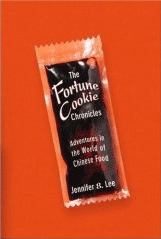« Has Bloomberg really eaten in the 2,500 Chinese restaurants in New York City? | Home | Is Harlem’s rezoning of 125th Street “ethnic cleansing?” »
Why hasn’t Korean cuisine gone mainstream?
By Jennifer 8. Lee | December 14, 2007
Earlier this week, my editor and I flew out to Ann Arbor to have dinner with a number of Borders Books and Music executives, arranged by the sales rep, Jill (yay!). The restaurant we chose was Pacific Rim, which is this nice Asian fusiony place (think adjectives like “lemongrass,” “coconut curry” and “five-spice” sprinkled out the menu which featured meats like raw tuna, duck and lamb). So they asked me to comment on the food, which I really couldn’t because it wasn’t very Chinese, except for the “five-spice.” I made two comments, a straight Chinese restaurant couldn’t charge that much for entrees (mid-$20s) because Americans just generally refuse to pay that much for Chinese food, something that has sunk many an ambitious Chinese restaurateur. And the other thing I noticed, which surprised me for a restaurant like this, was that the chopsticks were flat and metal, Korean-style. Turns out that Pacific Rim used to be a family-owned Korean restaurant, which then evolved when the couple’s son took over.
Which then got us into another point, which is that Korean food is really one of the last break-out Asian cuisines in America. After all, urban-y Americans will frequently head out for Chinese, Japanese, Vietnamese, Thai, and Indian. But Korean restaurants still remain largely venues for Koreans.
I’m not sure why Korean cuisine hasn’t taken off, and neither are others. It’s probably a combination of supply and demand. Perhaps because Korean immigrants, in New York City at least, have focused on delis and nail salons instead of restaurants. So you don’t get that influx of cheap Korean restaurants you see with Chinese, Thai and Vietnamese. Korean food can actually quite pricey compared to the others when you order the grilled BBQ dishes. Some theories are that Korean food hasn’t been “dumbed down” or “Westernized” enough and thus the palate is slightly off for Americans — too spicy, too kim chee-y, too garlicky. You can kind of tell this in that there are no standardized mainstream names for the Korean dishes (i.e. Vietnamese “summer rolls”) or the dish names are not common enough to be thrown around (“pad thai” and “teriyaki”). In contrast, Chinese dishes have done a pretty good job over the years making their names accessible. Beef with broccoli is, well, beef with broccoli. Chicken with cashew nuts, etc. Exception: with shrimp in lobster sauce, there is no lobster in “lobster sauce.” Lobster sauce is the sauce that lobster would be cooked in. (So the funny thing is that in other parts of the country, you will often stumble upon Japanese and Chinese restaurants owned by Koreans).
Of course the Koreans can do mainstream Asian. Everyone is going nuts with the frozen yogurt places in Los Angeles, New York and elsewhere: Pinkberry, Red Mango, Kiwiberry etc.
Of course, one of the more unusual Korean restaurant evolutions I have ever witnesses is the Mill Luncheonette/Restaurant near Columbia University which, when I was growing up, was a diner type with formica countertops, swivel stools and Jewish homestyle cuisine . Somewhere along the line, a Korean family must have bought it, because it began this odd piecemeal transition into a Korean restaurant. First babimbap rice bowls appeared on the scrawled menu specials alongside the burgers, then even as they kept the counter, they introduced table service with Korean food, and then Korean cultural items started appearing on the walls. Then one day it closed for renovation and it reopened as a full-fledged Korean restaurant but still had lime rickeys and egg creams on its menu. It’s not bad, for that part of the city. It’s not Koreatown, but that part of Broadway has become a mini-Asia strip, where two Asian minigroceries (Japanese and Korean), bubble tea, the Korean restaurant, some upscale non-Asian food shop called Wu and Nussbaum (I’m assuming Wu is someone Asian, but who knows?).
Re Korean food. My family (which is Chinese) actually usually goes out for Korean food for Thanksgiving and other celebratory occasions. (By common consensus some years ago, we decided that we hated roast turkey. Too dry and bland, so my mom’s random experimentation with American culinary traditions came to a grinding halt). The place we most often head out to is Palisadium which is this 1970s-era bar-lounge-complex-recycled-as-Korean-restaurant-which-hosts-weddings-and-high-school-reunions which overlooks the banks of the Hudson River in Cliffside Park. (To give you a sense of the incongruity of the place, it has fireplaces and mirrors on the ceiling).
Anyway, I think the reason we head out of Korean is that from our perspective it’s familiar (i.e. close to Chinese food with chopsticks and rice) but special (in that we can’t make it ourselves). The funny thing is we order the SAME THING every single time we go: chap chae vermicelli noodles, bulgolgi grilled beef, kalbi grilled short rib, pajun pancake, etc. etc. Last time, I quipped as I was ordering, “I feel like an American ordering in a Chinese restaurant.”
Topics: Chinese Food | No Comments »
Comments are closed.

